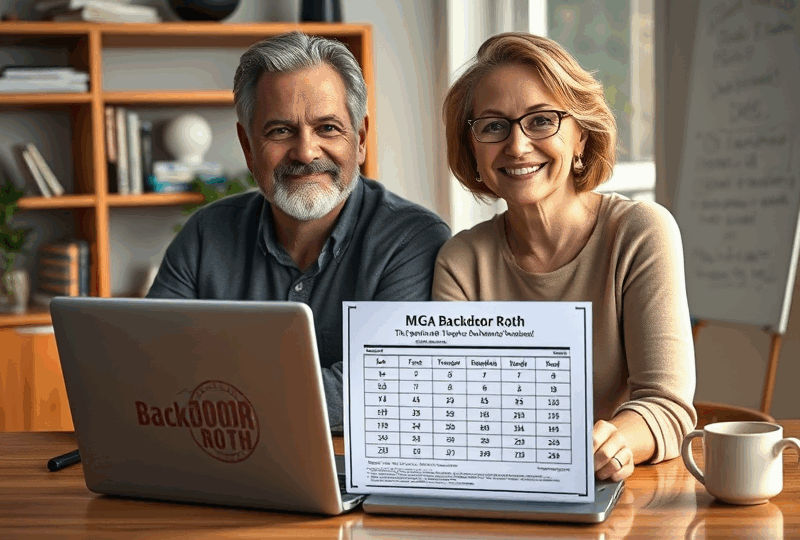
Mega Backdoor Roth: Maximize Your Retirement Savings with This IRS-Approved Strategy

Saving for retirement is one of the most important financial goals for Americans, and the Mega Backdoor Roth IRA is a powerful yet often overlooked strategy that can help high-income earners supercharge their retirement savings. If you’re looking to contribute more than the standard limits to a Roth IRA, this IRS-approved method could be a game-changer for your financial future.
What Is a Mega Backdoor Roth IRA?
The Mega Backdoor Roth IRA is a strategy that allows individuals to contribute significantly more to a Roth IRA than the standard annual limit by using after-tax contributions to a 401(k) plan and then converting those contributions to a Roth IRA or Roth 401(k). While the name might sound complex, the concept is relatively straightforward if your employer’s 401(k) plan allows it.
In 2023, the total 401(k) contribution limit (including employee and employer contributions) is $66,000 for individuals under 50, and $73,500 for those 50 and older (IRS.gov). The Mega Backdoor Roth takes advantage of the difference between the standard employee deferral limit ($22,500) and the total contribution limit by allowing after-tax contributions up to the maximum.
How Does the Mega Backdoor Roth Work?
Here’s a step-by-step breakdown:
1. Contribute the maximum pre-tax or Roth amount to your 401(k) ($22,500 for 2023).
2. If your employer allows it, make additional after-tax contributions up to the total 401(k) limit.
3. Roll over the after-tax contributions to a Roth IRA or convert them within the 401(k) to a Roth 401(k).
This strategy allows you to potentially contribute tens of thousands of dollars more into a Roth account each year, where your investments can grow tax-free.
Who Is Eligible for the Mega Backdoor Roth?
Not everyone can take advantage of this strategy. You must:
– Have access to a 401(k) plan that allows after-tax contributions.
– Be able to make in-service withdrawals or in-plan Roth conversions.
– Have sufficient income to contribute beyond the standard limits.
It’s most beneficial for high-income earners who are already maxing out their traditional or Roth 401(k) contributions and want to save more in a tax-advantaged way.
Benefits of the Mega Backdoor Roth
– Massive tax-free growth potential.
– No income limits for contributions (unlike a regular Roth IRA).
– Allows high earners to bypass Roth IRA income restrictions.
– Flexibility to convert funds either to a Roth IRA or Roth 401(k).
Potential Drawbacks and Considerations
– Not all 401(k) plans support after-tax contributions or in-service rollovers.
– Requires careful tracking of contributions and conversions to avoid tax complications.
– May involve additional administrative steps or fees.
It’s important to consult with a financial advisor or tax professional to ensure you’re following IRS rules and optimizing your strategy.
How to Set Up a Mega Backdoor Roth
1. Check with your HR or plan administrator to confirm if your 401(k) plan allows after-tax contributions and in-service rollovers.
2. Max out your standard 401(k) contributions.
3. Contribute additional after-tax dollars up to the annual limit.
4. Set up automatic or periodic rollovers to a Roth IRA or in-plan Roth conversion.
Some employers offer automatic in-plan Roth conversions, which simplifies the process.
Comparison: Mega Backdoor Roth vs. Backdoor Roth IRA
While both strategies aim to bypass Roth IRA income limits, the Mega Backdoor Roth allows for significantly higher contributions. The traditional Backdoor Roth IRA involves making a non-deductible IRA contribution and converting it to a Roth IRA, limited to $6,500 per year (2023). In contrast, the Mega Backdoor Roth can allow contributions of over $40,000 annually, depending on your plan.
Final Thoughts
The Mega Backdoor Roth IRA is a powerful retirement savings tool for high-income earners who want to maximize their tax-advantaged savings. While it requires a compatible 401(k) plan and some administrative effort, the long-term benefits of tax-free growth can be substantial. As always, it’s wise to work with a qualified financial advisor to ensure the strategy aligns with your overall retirement plan.
Disclaimer
This article is for informational purposes only and does not constitute financial, tax, or legal advice. The Mega Backdoor Roth strategy involves complex IRS rules and plan-specific details. Please consult with a licensed financial advisor or tax professional before implementing any investment or retirement strategy.
Sources:
– IRS.gov – Retirement Topics – 401(k) and Profit-Sharing Plan Contribution Limits
– IRS.gov – Roth IRAs








답글 남기기